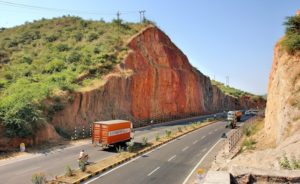India, one of the largest country in the world and second most populated country after china. To support increasing demand for raw material and finished good, it requires a well-developed transportation system. Every year nearly 8 billion people travel across India via railways and railways contribute in transporting 1050. 18 million tons of freight every year, but railways alone is not capable of handling demand of 1.2 billion people. As the economy boomed it become important to concentrate on road infrastructure as well, and Indian government initiated the construction of Golden Quadrilateral.
It is basically a network of highways that connect the four major metropolitan cities of the country in four directions – Delhi (North), Chennai (South), Kolkata (East) and Mumbai (West) – thereby forming a quadrilateral, and hence the name Golden Quadrilateral. Other metropolises also connected by the network are Ahmedabad, Bengaluru, Bhubaneswar, Jaipur, Kanpur, Pune, Surat, Nellore, Guntur, Vijayawada, and Visakhapatnam. The largest highway project in India and the fifth longest in the world, started by NDA Government led by Prime Minister Atal Bihari Vajpayee it is the first phase of the National Highways Development Project (NHDP).
Our roads don’t have a few potholes. Our potholes have a few roads.
-Atal Bihari Vajpayee
The Golden Quadrilateral passes through 13 states:
Andhra Pradesh – 1,014 km (630 mi)
Uttar Pradesh – 756 km (470 mi)
Rajasthan – 725 km (450 mi)
Karnataka – 623 km (387 mi)
Maharashtra – 487 km (303 mi)
Gujarat – 485 km (301 mi)
Odisha – 440 km (270 mi)
West Bengal – 406 km (252 mi)
Tamil Nadu – 342 km (213 mi)
Bihar – 204 km (127 mi)
Jharkhand – 192 km (119 mi)
Haryana – 152 km (94 mi)
Delhi – 25 km (16 mi)
Total – 5,846 km (3,633 mi)
Major highlights of the Golden Quadrilateral
- Planning for the Golden Quadrilateral project was completed in 1999. The project included construction of a few new express highways and extension of the existing road to four or six lanes. The project was officially started in 2001.
- The overall length of the quadrilateral is 5,846km. The project consisted of constructing/expanding four and six lane express highways. Upon completion it connected four major metro cities of India i.e. Delhi, Mumbai, Chennai and Kolkata.
- The Golden Quadrilateral passes through 13 states of India. Andhra Pradesh shares highest length of road (1014 Km) and Delhi has lowest (25 Km).
- To complete Golden Quadrilateral, the whole project was divided into four sections. Section I was a 1,454 km stretch of National Highway from Delhi to Kolkata. Section II was a 1,684 km stretch from Kolkata to Chennai. Section III was a 1,290 km stretch from Chennai to Mumbai. Section IV is a 1,419 km stretch between Mumbai and Delhi.
Benefits for the country
- Provides faster transport networks between major cities and ports
- Provides connectivity to major agricultural, industrial, and cultural centres of India
- Provides smoother movement of goods and people within the country
- Enables industrial development and job creation in smaller towns through access to varied markets
- Farmers are able to transport their produce to major cities and towns for sale and export, and there is less wastage and spoils.
- More economic growth through construction and indirect demand for steel, cement, and other construction materials
- Giving an impetus to truck transport
References: mapsofindia, knowledgeofindia and wikipedia












